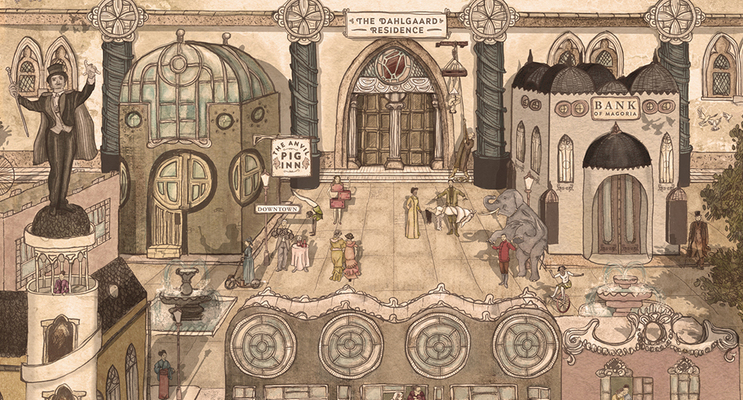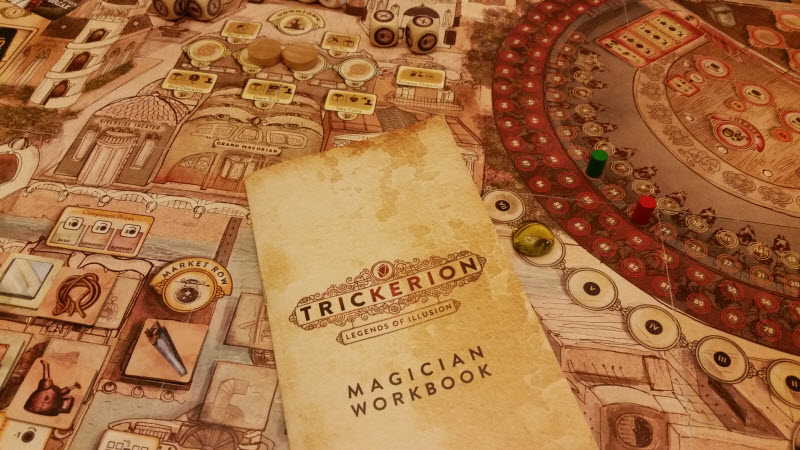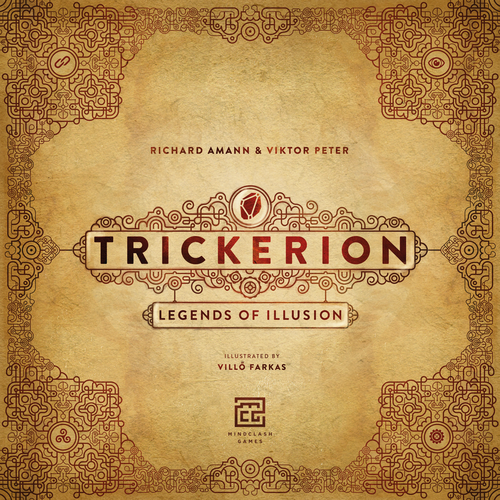As part of our December Spotlight on Trickerion, we strive to inform readers of little extra tidbits surrounding the game. Games are made by people, and one of those tidbits we enjoy is learning a little bit more about the people behind them. Some designers shy away from the public stage, while others enjoy being front and center.
In the case of designers Richard Amann and Viktor Peter, their first time on center stage has proved to be an exciting but bewildering experience. From spending several years behind the scenes developing the act that would become Trickerion to scrambling to add in bonus Kickstarter content due to impressive ticket sales, there has never been a dull moment for these burgeoning designers. In a sense, the entire process has been a high-wire act, and while they’ve thought numerous times they’d go tumbling off from the ordeal of creating their first game, all early signs point to a spectacular performance.
As for an ensuring encore in the City of Illusion, well, that remains to be seen.
Still, one shouldn’t miss out heading down to Magoria. In this middle-weight Euro game set in the late 1800s, players return to a time when stage acts and vaudeville were reaching the height of their skills – and where great stage magicians still astounded audiences with their ancient craft. From amusing stories to death-defying feats, people came from all around to see the legends perform.
You are one of those legends.
In Trickerion, players are renown illusionists of various styles. Each of you have been summoned by a former legendary magician who has mysteriously reappeared after vanishing decades ago at the top of his game. He seeks to pass on what he knows, as well as the mystical Trickerion Stone, to the person who he deems most worthy. Using a modified form of worker placement, players must procure plans for various magic acts, acquire the materials to pull them off, and slot shows into the local theater to show off their skills. And you only have 5 weeks to pull it off.
Because of that, time will not be on your side. There’s costumes to get, crews to hire, and…how exactly does one find doves in this region anyhow? Good luck finding out!
To that end, we thought you might be up for learning a few tricks of the trade to get yourself started. And who better to teach you than Trickerion’s architects themselves? Richard and Viktor graciously took the time to step off their own stage to impart some wisdom to fellow magicians. Just watch your wallets. They’re sneaky like that.
Enjoy!
Round One Questions
CR: What was your Gateway Game?
Viktor: I’d say the family version of Agricola from about 5 years ago. The full game is still one of my favorites – I think I have at least 60-70 plays under my belt.
Richard: I think it was Cuba or Puerto Rico, or another exotic country. They both had a great impact on me, I think even today I would sit down with both of them any time to play a round.
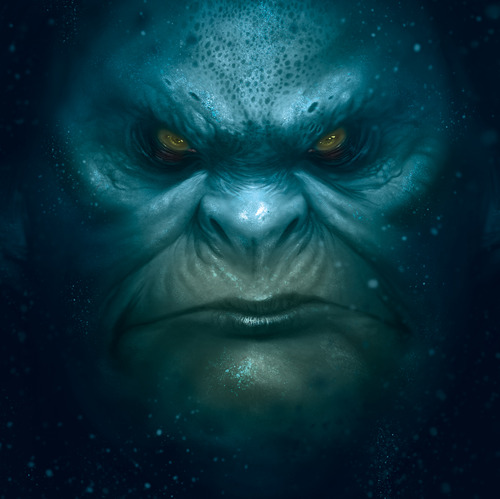 CR: What was the last game you really enjoyed playing (besides Trickerion)?
CR: What was the last game you really enjoyed playing (besides Trickerion)?
Richard: I’m really enjoying Abyss, because despite its simple rules it grants a lot of strategic depth. Even my father was okay to play with it, which is a big thing! Dominant Species was a game I only played once earlier this year too, but I can say it was one of my best gaming experiences this year.
Viktor: I just fell in love with Android: Netrunner during the past few weeks. It seems like one of those long-lasting, and very expensive affairs.
CR: How big is your game collection?
Viktor: My BGG page says 37, but I’m not very good at cataloging stuff; I think it’s closer to 50-60. It’s not so big, but frankly I’ve been pouring a major part of my gaming budget into CCGs and LCGs…
Richard: I’m not a big collector of games. I think I have around 15, but we have a lot ‘company games’ now, and Viktor’s collection is quite big enough to always have something to play with, not to mention our friends’ games. If we’d like to try something new we can always go to a gaming club. Usually I only buy those games that I can’t resist, no one else around me has it, or I am sure that even non-gamer friends and relatives would enjoy it and I won’t get bored after 10 minutes either.
CR: What is your favorite type of game to play?
Viktor: I prefer heavy Euros, and, in general, games that allow me to build something from the ground up. That usually takes time – when a game box says 90+ minutes of play time, that’s when it actually starts tickling my curiosity!
Richard: I am also a fan of Euro games, but I am fine with simpler games as well. I enjoy games where the outcome of the game is in my hands rather than fates.
CR: How do you feel about Monopoly?
Richard: As a kid I could hardly get my parents to play it because it took forever to end a game. I actually can’t remember that we managed to finish the game even once. Anyway, I enjoyed it back then because there was ‘grown-up stuff’ going on, like building houses, etc. If it weren’t for the PR and the Good Ol’ Times legacy I think this game would vanish from the market because it’s way less fun than its length and luck factor would necessitate, and there are far better games for kids today.
Viktor: Unlike most board game fans, I don’t despise Monopoly. I just don’t really think it’s even a real game. That said, I admit having had actual fun with the one with the credit card readers found in one of the newer editions in the first 10 minutes (because of the credit card readers).
On Trickerion
CR: You’ve said elsewhere that Trickerion’s theme is based in part on the time and setting of the movie The Prestige. What was it about that movie that really resonated as a game concept?
Richard: Rivaling illusionists was a basic situation that was definitely missing from the board game market, so we saw an opportunity there. The era of the movie was a really exciting one, and the universe Christopher Nolan created had so much mystery, machination and contemplation around struggling for prestige that we really wanted to stay around this period. Of course, we had our own interpretation of the world of magic in an imaginary period of history though.
CR: Did you end up doing a lot of research on that era of stage performing, vaudeville, etc.? If so, did any story really stand out?
 Richard: We were exploring antique stores for old books about magic, and we found some really great ones that were first published around the end of the 19th century, so we had quite a good idea about how magic tricks were performed and what stage performers were like back than. We used this basic idea as a core of our creative concept, but we always imagined a world that holds just as much real magic as illusion, just like in the Prestige movie.
Richard: We were exploring antique stores for old books about magic, and we found some really great ones that were first published around the end of the 19th century, so we had quite a good idea about how magic tricks were performed and what stage performers were like back than. We used this basic idea as a core of our creative concept, but we always imagined a world that holds just as much real magic as illusion, just like in the Prestige movie.
So, we did not stick with history and instead built a fantasy world around an existing era, which made the world of Trickerion much more exciting. Movies like the Prestige, The Illusionist, and the Houdini miniseries were great inspiration source as well, but we also visited real magic shows.
The way we ended up working with [renown real-life magician] SOMA is actually a great story. I think I had the idea from the very beginning that some day I’d contact him about our project, but I never really thought that he would be so helpful and enthusiastic. One day I wrote a really long letter to SOMA saying that we loved his work, how inspiring he was for us, and if he would like to participate in our project. Luckily for us, SOMA is not only a magician but one of the most creative people I have ever known. He also designs board games and he likes to create videos, so he was excited about this project just as much we were. We had a lots of fun together preparing for the campaign, and today I think I can say that we became friends, which is the best outcome that was possible for a collaboration like this.
CR: The artwork of Trickerion really reinforces its era and theme. How did you end up deciding to go the direction you did with artist Villo Farkas?
Richard: Our benchmark for the game was Jumanji – the game version from the movie. A game lost and found in the loft under a ton of dust girded by mystery. We wanted to create something special that doesn’t only stand out because of the quality of the artwork but is something different than what people are used to. Since Villo always strives to create something unique and different, she was happy with this creative direction, but it wasn’t easy for her either to find the atmosphere that represented all this.
CR: Trickerion did phenomenally well on Kickstarter, raising almost ten times the original launch goal. What do you think was it about the game that caught people’s interest so much?
Viktor: I think it was definitely the theme. Trickerion was, plainly, “the Magician board game” at that time, which is something that’s unusual enough to be noticed. Plus, I know at least 20 of our backers who are actual magicians!
Richard: We also wanted to entertain people while the campaign lasted and to always have something new or interesting to be excited about. I think this also helped a lot, because people liked to be part of the campaign, and they started to talk about it.
CR: You’ve said previously there was a mad scramble for stretch goals for the campaign due to how fast it funded. Was there anything originally in Trickerion that didn’t make it into the final game you wish had, either as a stretch goal or expansion?
V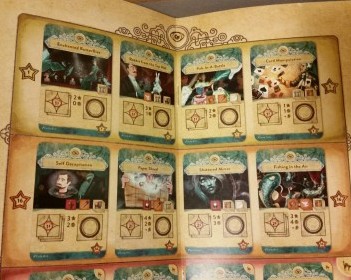 iktor: We were on and off about adding metal coins for a long time, especially since many of our backers really seemed to dig the idea. We eventually decided not to, and while it would have been very cool to see those coins in metal, in retrospect I still think it was a good call. I’m afraid we wouldn’t have been able to match the quality level of some of the better ones that are already out there, and it would almost certainly have delayed the project further.
iktor: We were on and off about adding metal coins for a long time, especially since many of our backers really seemed to dig the idea. We eventually decided not to, and while it would have been very cool to see those coins in metal, in retrospect I still think it was a good call. I’m afraid we wouldn’t have been able to match the quality level of some of the better ones that are already out there, and it would almost certainly have delayed the project further.
CR: One in-game thing we’re curious about is that materials are not consumed when your trick is created, which is different than most Euro games. What was the design thought process on that?
Viktor: While I think the way the market works is pretty cool, we didn’t want it to take the focus away from the Theater and preforming too much. With the current system, you can get away with 3-4 visits to the Market during a full game, which is exactly where we wanted to be. The game is all about planning ahead, and planning your Trick advancement to make the best use of your component stacks played into this concept nicely. I think it reflects reality better, too – even in the Prestige, Angier worked out a method to save the bird during the cage trick to use it later, didn’t he?
CR: Also, we have to know: what sort of special powers does the Trickerion Stone have, really? Like, what could we use it for besides stage performances?
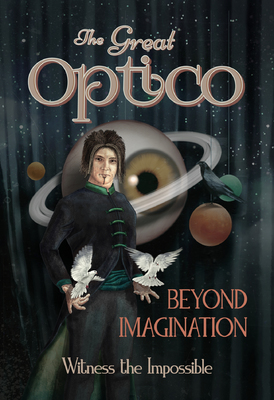 Viktor: The Trickerion Stone helps you expand your mind, soul, and physical powers. It’s like a natural – or rather supernatural – doping of unknown origin. Dahlgaard himself found it accidentally in a hidden cave once he was exploring the famous Cascade of Erion. The name itself comes from here as well, as the stone was a really tricky one. Dahlgaard named it the Trick of Erion, shortly Trickerion thereafter.
Viktor: The Trickerion Stone helps you expand your mind, soul, and physical powers. It’s like a natural – or rather supernatural – doping of unknown origin. Dahlgaard himself found it accidentally in a hidden cave once he was exploring the famous Cascade of Erion. The name itself comes from here as well, as the stone was a really tricky one. Dahlgaard named it the Trick of Erion, shortly Trickerion thereafter.
One could use its power to almost anything where psychological or physical power was needed. Dahlgaard knew that it could never get into wrong hands, so he kept it a secret, and he chooses his successor wisely to make sure the stone would not be used for wrong purposes. Entertaining and inspiring an audience is certainly not one of those.
CR: Well, we’re out…
At any rate, Trickerion’s magicians cater to one of four schools of illusion. Do you have a personal style preference?
Viktor: Mine is certainly Spiritual. Those Tricks mostly have a darker, gloomier feel, and they add a touch of fantasy to the game, which I think it really needs.
Richard: It’s really hard to say. I also love the Spiritual tricks, but the Mechanical and Escape tricks are close to me too, just as the Optical ones. I think it depends on my mood which one is the actual favorite.
CR: Lastly, which of the game’s tricks would you most like to see performed in real life?
Viktor: Hellhound, a late-game Mechanical trick, is a purely made-up one, but frankly, who wouldn’t want to see a giant, three-headed, flame-breathing hound appear on the stage?!?
Richard: Well, the Teleported Man would be something I would definitely see in real life. I would be wondering of course though if there was a man choking in a water tank under the stage…
Photo Credits: Trickerion cover and artwork by Mindclash Games; SOMA photo by SOMA show website.

